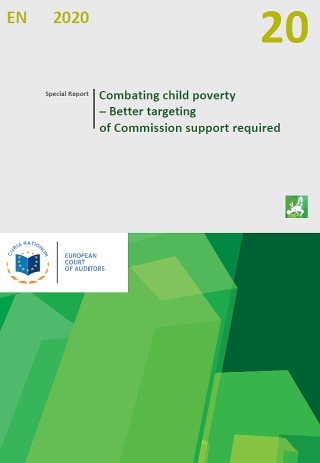Child Poverty in the EU - greater focus needed

The report ''Combating child poverty – Better targeting of Commission support required' by the European Court of Audtiors (ECA) concludes that it is almost impossible to assess how the EU contributes to Member States’ efforts to reduce child poverty. The ECA report finds that the relevance and strength of EU instruments examined are limited because they are not legally binding – and more powerful tools, such as the European Semester or support from EU funds, rarely address child poverty specifically.
Almost one in four children in the EU is at risk of poverty or social exclusion. Yet studies have shown that the economic benefits of investing in children significantly outweigh the initial financial costs. In the EU, the fight against child poverty lies in the hands of each Member State. The European Commission’s role is to complement and support national child poverty actions through both legal and financial instruments.
The report also finds that child poverty remains a serious issue in the EU which is not conducive to a sustainable, inclusive and fair society, and unfortunately, child poverty is likely to become even more prevalent in the aftermath of the ongoing COVID-19 crisis. It is therefore imperative that future EU funding and policy initiatives for tackling child poverty are based on reliable information to ensure a positive impact on the level of child poverty in the EU.
The report notes that the 2013 Commission Recommendation “Investing in children: breaking the cycle of disadvantage” was a positive EU initiative to combat child poverty in an integrated way. Despite this, the absence of measurable targets and milestones make it impossible to assess how well it has been implemented and the Recommendation has had only a minimal impact on Member States’ national policies.
The 2017 European Pillar of Social Rights (EPSR) is another non-binding instrument that is available to combat child poverty. The report notes that the EPSR has increased awareness of social policies in the EU.
Fighting poverty and social exclusion is an integral part of the Europe 2020 strategy, which set a target of lifting at least 20 million people out of poverty by 2020. The auditors point out that progress towards the target has been limited, and that it is unlikely to be reached. The European Semester coordinates national efforts to achieve the strategic targets, primarily by issuing country-specific recommendations (CSRs) to Member States on key economic and social issues. But the ECA found that CSRs rarely address child poverty explicitly.
Finally, the report highlights the fact that children living in poverty are not an explicit target group for EU support. It is unknown how much funding has been allocated directly to combating child poverty or what has been achieved in this area. Looking forward, the report warns that, owing to this lack of information, there is a risk that appropriate action may not be taken and adequate funds may not be available when designing the future European Child Guarantee or other policy initiatives.
With a view to contributing to the EU’s future initiatives for the new programming period, the report recommends that the European Commission:
• include actions and objectives to tackle child poverty in its EPSR action plan;
• ensure clear internal guidance for situations that could lead to a potential CSR directly addressing child poverty;
• target and monitor investment in tackling child poverty in the 2021-2027 period; and
• ensure that sufficient reliable evidence supports the upcoming European Child Guarantee.